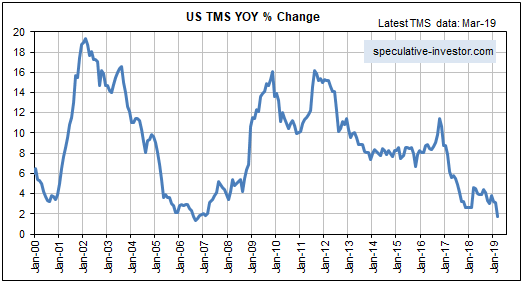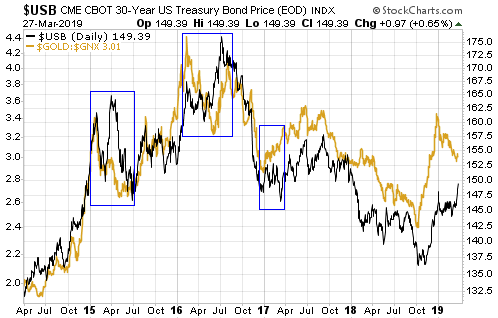If you look hard enough you will always be able to find reasons that the gold price is about to rocket upward, because such reasons always exist regardless of whether gold’s prospects are bullish or bearish. More generally, searching for reasons that something specific is about to happen is a bad way to speculate or invest because it will always be possible to find evidence to support any preconceived view. Rather than attempting to justify preconceived views, it is much better to approach the markets with an open mind and to base buy/sell decisions on objective indicators with good long-term track records.
One of the financial world’s most reliable indicators is the gold/commodity (g/c) ratio. The g/c ratio is more predictable than the US$ gold price, or to be more accurate the g/c ratio has a more consistent relationship with other markets than does the US$ gold price. This is possibly because removing the ever-changing dollar from the equation suppresses ‘noise’ and amplifies ‘signal’.
The following chart is an example of the g/c ratio’s consistent, and therefore predictable, relationship with another market. It shows that almost all of the time the g/c ratio (as represented by the US$ gold price divided by the GSCI Spot Commodity Index) trends in the same direction as credit spreads (represented here by the IEF/HYG ratio).
The relationship depicted below is sufficiently reliable that if you know, or at least have a good idea regarding, what will happen to credit spreads over a certain period, then you will be able to accurately forecast whether gold will strengthen or weaken relative to the average commodity over the period. By the same token, knowledge about whether gold is poised to strengthen or weaken relative to the average commodity leads to a high-probability forecast about credit spreads.
There are other inter-market relationships involving the g/c ratio that work just as well as the one mentioned above, and at the beginning of this year I used one of these to forecast that gold would be weak relative to commodities during the first half and strong relative to commodities during the second half of 2019. The first-half forecast has panned out to date. The second-half forecast still looks plausible but is subject to revision based on what happens to various indicators over the next couple of months.
Another of the financial world’s most reliable indicators is sentiment. An accurate reading of market sentiment doesn’t lead to specific conclusions about future price movements, and as discussed HERE there are pitfalls associated with using sentiment to guide buy/sell decisions. However, understanding how sentiment affects the markets can give an investor a decisive edge.
I’m not going to write about why or how sentiment can be used to good effect when attempting to time buys and sells in the financial markets. I’m also not going to mention the most useful indicators of market sentiment. The reason is that Bob Moriarty has covered this ground and more in his latest book: “Basic Investing in Resource Stocks: The Idiot’s Guide“. The Kindle version of the book is only US$6, or just a little more than the price of a large cappuccino at my local cafe.
Bob’s book is essential reading for anyone speculating in junior resource stocks, especially anyone who is inexperienced or hasn’t coped well with the huge swings in these stocks in the past.
At one point during the book I thought that Bob was making successful speculation in the stocks of small mining and oil companies seem too easy, because the hard reality is that even when you understand the most effective way to trade these stocks you still will stumble into traps from time to time. However, later in the book Bob warns the reader that large losses can happen even when all the ducks appear to be in a row. He does this by recounting some amusing stories about his own failed speculations and the management teams that helped to create these failures.
Even if you already know how to use sentiment and how to operate profitably at the speculative end of the stock market, you will get something out of the Bob Moriarty book linked above. It’s well worth the 6 bucks for the electronic version or the 12 bucks for the paper version.
 Print This Post
Print This Post



